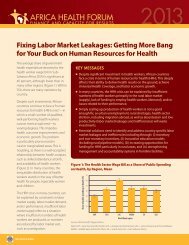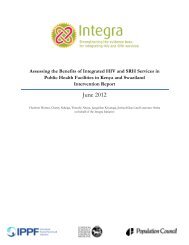ujh78
ujh78
ujh78
Create successful ePaper yourself
Turn your PDF publications into a flip-book with our unique Google optimized e-Paper software.
percentage points higher in rural areas than in urban areas (see Table 2.1). The inverse situation occurred<br />
in Liberia, where the prevalence of wasting was 8% in urban areas and 6% in rural areas--a discrepancy<br />
of 3 percentage points.<br />
The role of the household head’s sex and age<br />
Overall, there were no marked differences in the wasting prevalence by the sex and age of the<br />
household head in sub-Saharan Africa (see Figures 2.3 and 2.4). The difference by sex of head of<br />
household was substantial only in Nigeria, where the wasting prevalence was 13% for children living with<br />
a male household head and 9% for children living with a female household head (a difference of 4<br />
percentage points) (see Table 2.1). In Rwanda the wasting prevalence for children living with a household<br />
head less than age 50 (2%) was lower than that of children living with a household head who was at least<br />
age 50 (6%), a difference of 3 percentage points.<br />
Variations during the last 13 years<br />
The most important progress in reducing the wasting prevalence, in terms of percentage points,<br />
took place in Burkina Faso and Zimbabwe (see Table 2.2). The wasting prevalence in Burkina Faso was<br />
19% in 2003 and 14% in 2010, a decrease of 5 percentage points. In Zimbabwe the reduction between<br />
surveys was 4 percentage points (2005-06: 6% and 2010-11: 3%). The opposite shift occurred in Mali and<br />
Nigeria, where rates of wasting increased by about 3 percentage points (Mali 2001: 11% and 2006: 14%;<br />
Nigeria 2003: 9% and 2008: 12%) (see Figures 2.5 and 2.6).<br />
2.2 Stunting<br />
The term stunting refers to shortness-for-age; an indicator of chronic malnutrition calculated by<br />
comparing the height-for-age of a child with a reference population of well-nourished, healthy children.<br />
Stunting could be a sign of failure to attain linear growth potential as a consequence of suboptimal health<br />
and/or nutritional conditions (WFP, 2013; WHO, 1995).<br />
As Table 2.3 indicates, the stunting prevalence in Africa ranged from 50% in Niger and 51% in<br />
Burundi to 22% in Senegal. The Democratic Republic of Congo, Madagascar, and Malawi, as well as<br />
Niger and Burundi, had stunting prevalence above 40% (see Map 2.2.).<br />
Sex and geographic disparities<br />
In all countries, the prevalence of stunting among children less than age 5 was higher for males<br />
than for females (see Figure 2.7). This sex disparity was 6 percentage points higher for males than<br />
females in Burundi and 5 percentage points higher for males than females in Benin, Liberia, and Malawi<br />
(see Table 2.3).<br />
In every country the stunting prevalence in rural areas was higher than that in urban areas (see<br />
Figure 2.8). This difference was most pronounced among children in Burundi and Niger, where the<br />
stunting prevalence was 20 percentage points greater in rural areas than in urban areas. The country of<br />
Sao Tomé and Príncipe had the lowest geographic variation—2 percentage points higher in rural than<br />
urban areas; see Table 2.3).<br />
The role of the household head’s sex and age<br />
The sex of the household head played an important role in stunting prevalence, but the pattern<br />
was not consistent across countries. The stunting prevalence was at least one percentage point higher for<br />
children living with a male household head in 8 countries, but at least 1 percentage point higher for<br />
10








